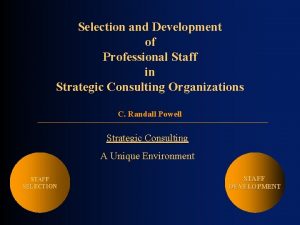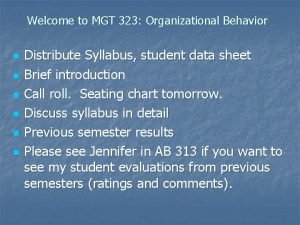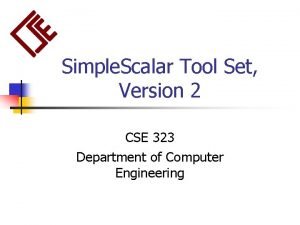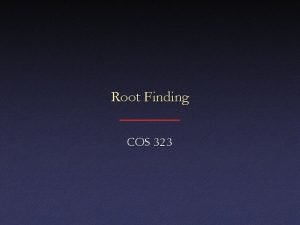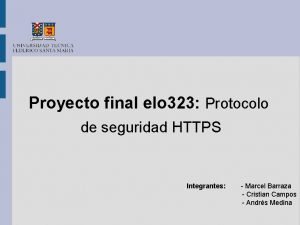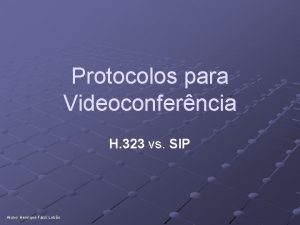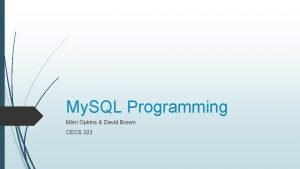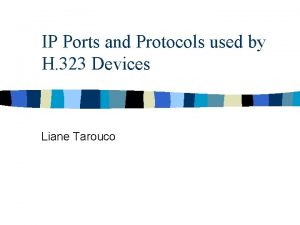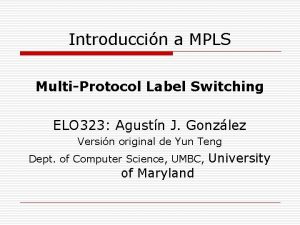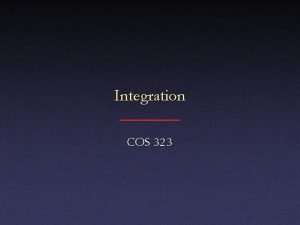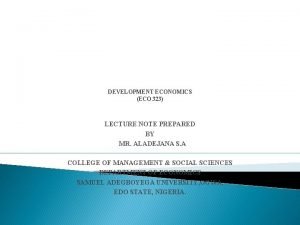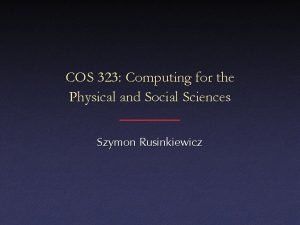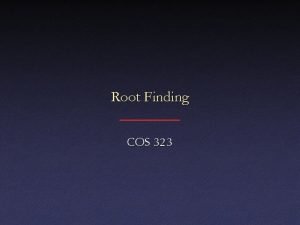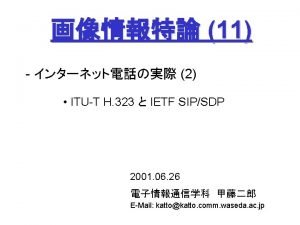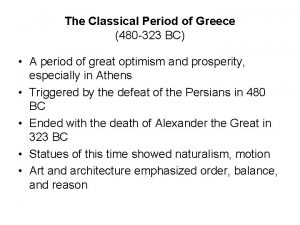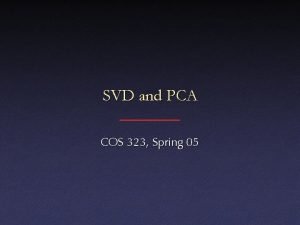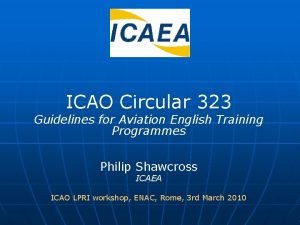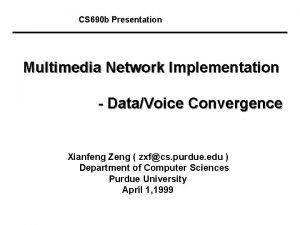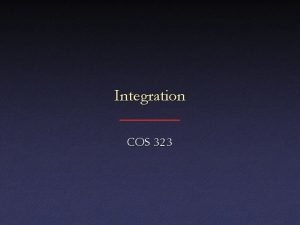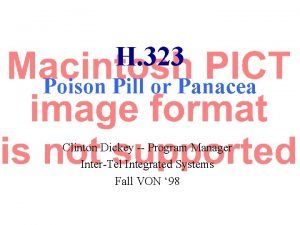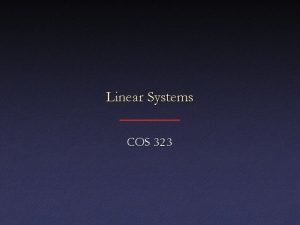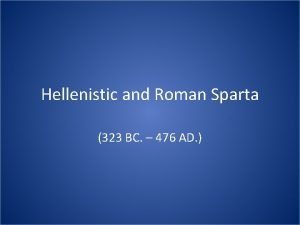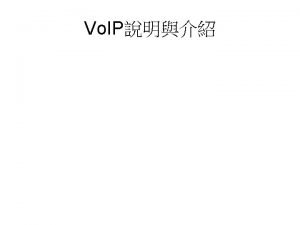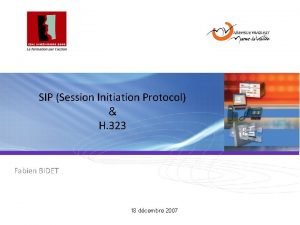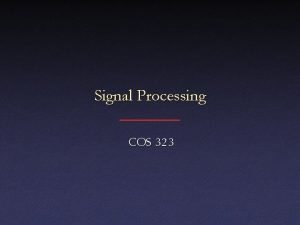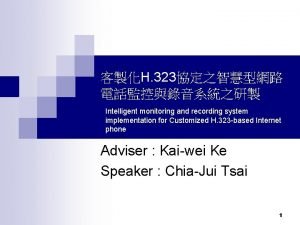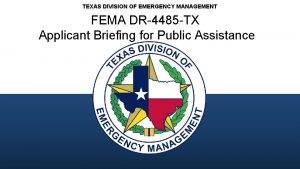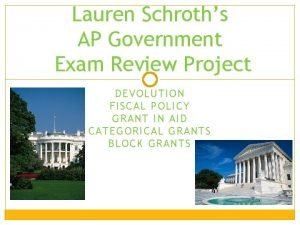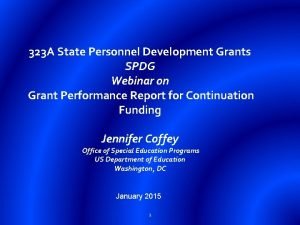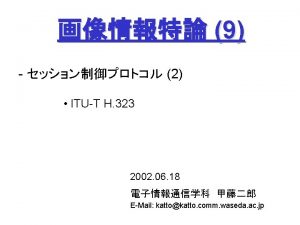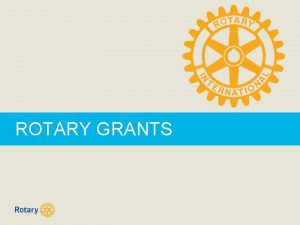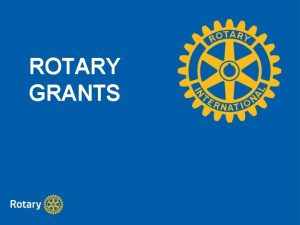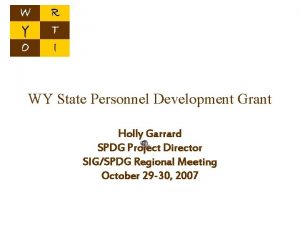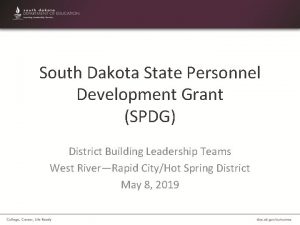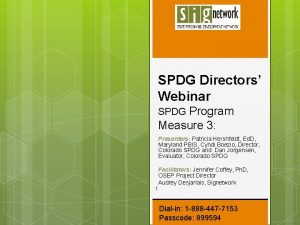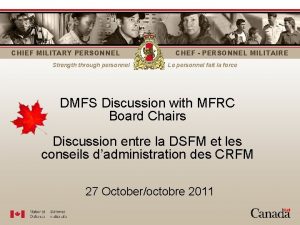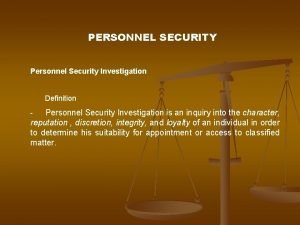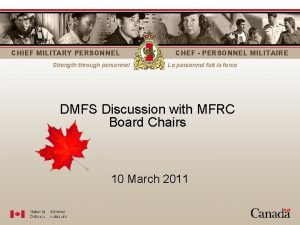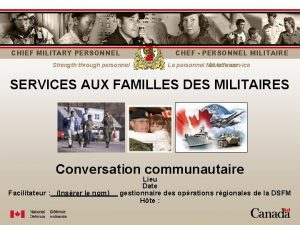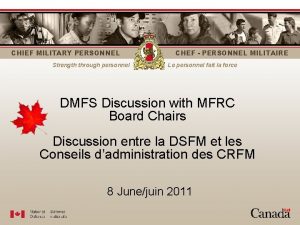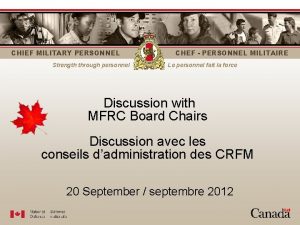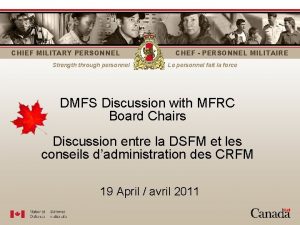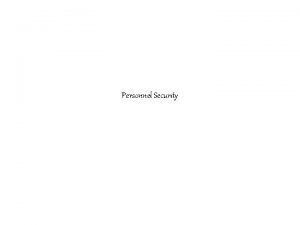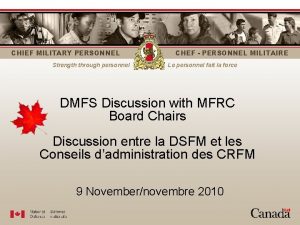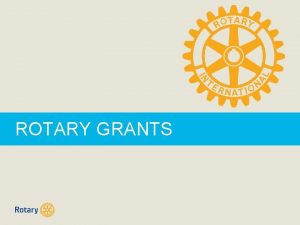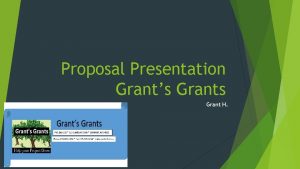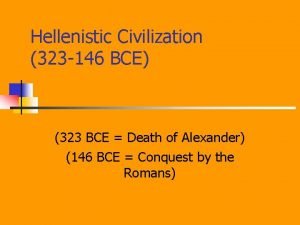State Personnel Development Grants SPDG CFDA 84 323













![[1 ] Absolute Priority 2 (overview) An applicant must submit a State Personnel Development [1 ] Absolute Priority 2 (overview) An applicant must submit a State Personnel Development](https://slidetodoc.com/presentation_image_h2/823bb3ad45bdf739f796b2abc32346ab/image-14.jpg)





























- Slides: 43

State Personnel Development Grants (SPDG) CFDA 84. 323 A Fiscal Year 2020 Office of Special Education Programs U. S. Department of Education

Note Regarding Webinar • Slides are for guidance only and information has been summarized due to logistics of the webinar. • Please read the entire Notice Inviting Applications (NIA). • Please review the recorded webinar titled “Applying for Office of Special Education Programs Discretionary Grants” for additional information related to submitting an application: https: //osepideasthatwork. org/resourcesgrantees/informational-webinars-osep-fundingopportunities 1

Today’s Topics • • Purpose of the SPDG Program Assistance for Developing Your Plan Absolute Priorities Definitions Contracts & Subgrants Government Performance Results Act (GPRA) General Requirements Selection Criteria 2

Purpose of the State Personnel Development Grant Program (SPDG) • The purpose of this program, authorized by the Individuals with Disabilities Education Act (IDEA), is to assist State educational agencies (SEAs) in reforming and improving their systems for personnel preparation and professional development in early intervention, educational, and transition services in order to improve results for children with disabilities. 3

Reminders • Informational Webinars do not take the place of reading through the entire application package. – Certain sections of the application package will be highlighted, but other important information will not be. • Best practice tips may be provided, but please keep in mind this is a peer-reviewed competition. • If you are receiving new SPDG money in FY 2020 you cannot apply for a grant. – Grantees in a no-cost extension may apply. • The only eligible applicants are State Educational Agencies (SEAs). 4

Other Sources of Assistance • The National Association of State Directors of Special Education, in partnership with OSEP, recorded a series of webinars that provide guidance to potential applicants for the SPDG program: https: //www. livebinders. com/b/2530809 5

Logic Models • OSEP also provides information on developing performance measures and logic models at https: //www. osepideasthatwork. org/logic. Model to assist you in preparing a quality application. 6

Absolute Priorities The notice contains three absolute priorities. …Absolute Priority 1 is from the notice of final priorities and definitions published in the Federal Register on August 2, 2012 (77 FR 45944). Absolute Priority 2 is from sections 651 through 655 of IDEA, as amended by ESSA. Absolute Priority 3 is from the notice of final priority and definitions for this program published elsewhere in this issue of the Federal Register (2020 NFP). 7

…Absolute Priority 3 constitutes its own funding category, and the Department intends to award 1/3 of the SPDG grants under this competition to grants under Absolute Priority 3, provided applications of sufficient quality are submitted. Applications will be rank ordered separately for Absolute Priority 3. Therefore, applicants must clearly identify if the proposed project addresses Absolute Priority 3. 8

Whether or not applicants are responding to Absolute Priority 3, they are required to respond to Absolute Priority 1 and 2.

Absolute Priority 1: In order to meet this priority, an applicant must demonstrate… (1) Use evidence-based (as defined in this notice) professional development practices that will increase implementation of evidence-based practices and result in improved outcomes for children with disabilities;

Absolute Priority 1 cont. Provide ongoing assistance to personnel receiving SPDG-supported professional development that supports the implementation of evidence-based practices with fidelity (as defined in this notice); and 11

Absolute Priority 1 cont. • Use technology to more efficiently and effectively provide ongoing professional development to personnel, including to personnel in rural areas and to other populations, such as personnel in urban or high-need local educational agencies (LEAs) (as defined in this notice). 12
![1 Absolute Priority 2 overview An applicant must submit a State Personnel Development [1 ] Absolute Priority 2 (overview) An applicant must submit a State Personnel Development](https://slidetodoc.com/presentation_image_h2/823bb3ad45bdf739f796b2abc32346ab/image-14.jpg)
[1 ] Absolute Priority 2 (overview) An applicant must submit a State Personnel Development Plan that identifies and addresses the State and local needs for the personnel preparation and professional development of personnel, as well as individuals who provide direct supplementary aids and services to children with disabilities… 13

Absolute Priority 3 States will meet the priority if they describe in their application how they will develop personalized professional development projects to carry out their State plan under section 653 of IDEA and implement professional development activities that are consistent with the use of funds provisions in section 654 of IDEA. This would be accomplished by using funds under the SPDG program for stipends or other mechanisms to provide personnel with choice in selecting professional development options that will count toward State or local professional development requirements, as appropriate, such as the number of hours personnel must fill or the competencies they must acquire to obtain or retain certification, and that are designed to meet their individual needs and thus improve results for children with disabilities. 14

If you are responding to Absolute Priority 3: (e) Describe--(1) The extent to which the proposed project will use professional development practices supported by evidence to support the attainment of identified competencies; (2) How improvement in implementation of SPDG-supported practices over time will be demonstrated by participants in SPDG professional development activities; (3) The extent to which the proposed project will use SPDG professional development funds to provide activities designed to sustain the use of SPDG-supported practices; ( 15

Absolute Priority 3 4) How the proposed project will determine whether special education teachers who meet the qualifications described in section 612(a)(14)(C) of IDEA, as amended by the ESSA, that have participated in SPDG-supported special education teacher retention activities remain as special education teachers two years after their initial participation in these activities; and (5) How the proposed project will assess whether and to what extent the project improves outcomes for children with disabilities. 16

Defining Terms – “Personnel” “As defined by section 651(b) of IDEA, the term “personnel” means special education teachers, regular education teachers, principals, administrators, related services personnel, paraprofessionals, and early intervention personnel serving infants, toddlers, preschoolers, or children with disabilities, except where a particular category of personnel, such as related services personnel, is identified. ” 17

Defining Terms -- Fidelity means the delivery of instruction in the way in which it was designed to be delivered. 18

Additional SPDG Requirements Projects funded under this program must- • (a) Budget for a three-day project directors' meeting in Washington, DC, during each year of the project; • (b) Budget $4, 000 annually for support of the SPDG Program website currently administered by the University of Oregon (www. signetwork. org); and • (c) If a project receiving assistance under this program authority maintains a website, include relevant information and documents in a form that meets a government or industry-recognized standard for accessibility. 19

Contracts & Subgrants (c) ---An SEA that receives a grant under this program-(1) Must award contracts or subgrants to LEAs, IHEs, parent training and information centers, or community parent resource centers, as appropriate, to carry out the State Personnel Development Plan; and (2) May award contracts and subgrants to other public and private entities, including the lead agency under Part C of IDEA, to carry out the State plan.

(d) Use of Funds for Professional Development. An SEA that receives a grant under this program must use-(1) Not less than 90 percent of the funds the SEA receives under the grant for any fiscal year for the Professional Development Activities described in paragraph (a); and (2) Not more than 10 percent of the funds the SEA receives under the grant for any fiscal year for the Other Activities described in paragraph (b). 21

GPRA: Performance Measures • Projects use professional development practices supported by evidence to support the attainment of identified competencies; • Participants in SPDG professional development demonstrate improvement in implementation of SPDG-supported practices over time; • Projects use SPDG professional development funds to provide activities designed to sustain the use of SPDG-supported practices; • Special education teachers who meet the qualifications described in section 612(a)(14)(C) of IDEA, as amended by the ESSA, and who have participated in SPDG-supported special education teacher retention activities remain as special education teachers two years after their initial participation in these activities; and • Projects improve outcomes for children with disabilities. 22

GPRA Resources • Materials http: //www. signetwork. org/content_pages/205 to assist applicants in planning to collect GPRA data. • Please review Rubric A: SPDG Evidence-based Professional Development Components Rubric to learn about the professional development components required for the SPDG grants. • Will need to describe the tool you will use to measure fidelity: https: //nirn. fpg. unc. edu/module-1/usableinnovations; https: //nirn. fpg. unc. edu/resources/activity-7 -2 -fidelity-module-7 -capstone-developing-fidelityassessment 23

Uncertainties • Describe potential sites you plan to work with. – We are aware that you may not know whether those sites will be virtual/hybrid this year. – We are also aware that sites may change, with approval from your Project Officer, if you are funded. • You are able to request a lower level of funding your first year to begin ramping up your activities as sites are ready. 24

General Requirements (a) Recipients of funding under this competition must make positive efforts to employ and advance in employment qualified individuals with disabilities (see section 606 of IDEA). (b) Each applicant for, and recipient of, funding must, with respect to the aspects of their proposed project relating to the absolute priority, involve individuals with disabilities, or parents of individuals with disabilities ages birth through 26, in planning, implementing, and evaluating the project (see section 682(a)(1)(A) of IDEA). 25

OSEP Expectations for Engaging Families in Discretionary Grants • Highlights: – Provision of training, technical assistance, and coaching to build the capacity of family members to participate fully in planning, implementing, and evaluating the project; – Provision of training, technical assistance, and coaching to build the capacity of all project staff to engage families equitably; – Provision of financial resources such as honoraria and stipends for childcare and travel, to support family members’ active participation in the project planning, implementation, and evaluation; and – Recruitment of family members for positions on projects, including using non-traditional recruitment and networking strategies. 26

OSEP’s Family Engagement Assumptions • Incorporating family perspectives and experiences into project operations benefits the project and its audiences. • Effectively engaging families requires projects to clearly plan for how they will engage families, build trusting and respectful partnerships, and identify the expected outcomes of the collaboration. • Effective engagement strategies incorporate current research. • Effective capacity building strategies are based on the most current research on adult learning principles and coaching. • Families need a continuum of support in order to effectively engage with projects, including culturally competent and traumainformed supports. • Engaging families requires commitment to carrying out intensive, ongoing work building and maintaining partnerships. • Effective family-staff partnerships can increase the project’s efficiency and effectiveness. 27

Funding Amounts – Estimated Available Funds: $11, 727, 418. – Estimated Range of Awards: $500, 000 - $2, 100, 000 (for the 50 States, the District of Columbia, and the Commonwealth of Puerto Rico). • In the case of outlying areas (United States Virgin Islands, Guam, American Samoa, and the Commonwealth of the Northern Mariana Islands), awards will be not less than $80, 000. – Other than the outlying areas, applicants must ask for $500, 00 or more for each of the 5 years.

Note: We will set the amount of each award after considering-(1) The amount of funds available for making the grants; (2) The relative population of the State or outlying area; (3) The types of activities proposed by the State or outlying area; (4) The alignment of proposed activities with section 612(a)(14) of IDEA, as amended by the ESSA; (5) The alignment of proposed activities with State plans and applications submitted under sections 1111 and 2101(d), respectively, of the ESEA; and (6) The use, as appropriate, of research and instruction supported by evidence.

Format and Page Limit Recommendations The application narrative (Part III of the application) is where you, the applicant, address the selection criteria that reviewers use to evaluate your application. We recommend that you (1) limit the application narrative to no more than 70 pages and (2) use the following standards: • A “page” is 8. 5" x 11", on one side only, with 1" margins at the top, bottom, and both sides. • Double space (no more than three lines per vertical inch) all text in the application narrative, including titles, headings, footnotes, quotations, reference citations, and captions, as well as all text in charts, tables, figures, graphs, and screen shots. • Use a font that is 12 point or larger. • Use one of the following fonts: Times New Roman, Courier New, or Arial. 30

Appendices Other Narrative Attachments (Upload and attach to Optional Project Narrative File). Upload the attachments as PDF or Microsoft Word documents (a read only, flattened PDF format is recommended) in the order they should appear in the application. Suggested order. . . o Reference List o Appendix A (See Dear Applicant letter and priority) o Other Appendices (See below) � Resumes/Vitaes � Letters � Supplementary Information 31

Note The Project Narrative Attachment Form should include the narrative (text) that addresses each of the selection criteria, listed elsewhere in this document. The selection criteria will be used to evaluate applications submitted for this competition. The narrative has recommended formatting and page limits (check the Page Limits section of this document formatting and page limit recommendations for the competition to which you are applying). The table of contents and list of priority requirements, if applicable, do not count toward the recommended narrative page limit. 32

Selection Criteria FY 2020, CFDA 84. 323 A 1. Significance (20 points) 2. Quality of the Project Design (25 points) 3. Quality of Project Personnel (10 points) 4. Adequacy of Resources and Quality of the Management Plan (20 points) 5. Quality of the Project Evaluation (25 points) 33 100 points

Significance (20 points) (i) The extent to which the proposed project is part of a comprehensive effort to improve teaching and learning and support rigorous academic standards for students. (ii) The extent to which specific gaps or weaknesses in services, infrastructure, or opportunities have been identified and will be addressed by the proposed project, including the nature and magnitude of those gaps or weaknesses. (iii) The extent to which the training or professional development services to be provided by the proposed project are of sufficient quality, intensity, and duration to lead to improvements in practice among the recipients of those services. (iv) The likelihood that the proposed project will result in system change or improvement. 34

Quality of the Project Design (25 points) (i) The extent to which the goals, objectives, and outcomes to be achieved by the proposed project are clearly specified and measurable. (ii) The extent to which the design of the proposed project is appropriate to, and will successfully address, the needs of the target population or other identified needs. (iii) The extent to which the services to be provided by the proposed project involve the collaboration of appropriate partners for maximizing the effectiveness of project services. 35

Quality of the Project Design (CONTINUED) (iv) The extent to which the design of the proposed project reflects up-todate knowledge from research and effective practice. (v) The extent to which the proposed project will establish linkages with other appropriate agencies and organizations providing services to the target population. 36

Quality of Project Personnel (10 points) (1) The Secretary considers the quality of the personnel who will carry out the proposed project. (2) In determining the quality of project personnel, the Secretary considers the extent to which the applicant encourages applications for employment from persons who are members of groups that have traditionally been underrepresented based on race, color, national origin, gender, age, or disability. (3) In addition, the Secretary considers the following factors: (i) The qualifications, including relevant training and experience, of the project director or principal investigator. (ii) The qualifications, including relevant training and experience, of key project personnel. 37

Adequacy of Resources and Quality of the Management Plan (20 pts) (i) The relevance and demonstrated commitment of each partner in the proposed project to the implementation and success of the project. (ii) The extent to which the budget is adequate to support the proposed project. (iii) The adequacy of the management plan to achieve the objectives of the proposed project on time and within budget, including clearly defined responsibilities, timelines, and milestones for accomplishing project tasks. 38

Adequacy of Resources & Quality of Management Plan (cont) (iv) How the applicant will ensure that a diversity of perspectives are brought to bear in the operation of the proposed project, including those of parents, teachers, the business community, a variety of disciplinary and professional fields, recipients or beneficiaries of services, or others, as appropriate. (v) The potential for continued support of the project after Federal funding ends, including, as appropriate, the demonstrated commitment of appropriate entities to such support. 39

Quality of the Project Evaluation (25 points) (i) The extent to which the methods of evaluation are thorough, feasible, and appropriate to the goals, objectives, and outcomes of the proposed project. (ii) The extent to which the methods of evaluation are appropriate to the context within which the project operates. (iii) The extent to which the methods of evaluation provide for examining the effectiveness of project implementation strategies. (iv) The extent to which the methods of evaluation include the use of objective performance measures that are clearly related to the intended outcomes of the project and will produce quantitative and qualitative data to the extent possible. 40

Quality of the Project Evaluation (CONTINUED) (v) The extent to which the evaluation will provide guidance about effective strategies suitable for replication or testing in other settings. (vi) The extent to which the methods of evaluation will provide performance feedback and permit periodic assessment of progress toward achieving intended outcomes. (vii) The extent to which the evaluation plan clearly articulates the key project components, mediators, and outcomes, as well as a measurable threshold for acceptable implementation. 41

THANK YOU! Jennifer. Coffey@ed. gov 202 -245 -6673 Grants. gov Support Desk Email at: support@grants. gov 1 -800 -518 -4726 Grants. gov training: https: //grantsportal. psc. gov/Welcome. aspx? pt=Gr ants 42
 Strategic-personnel-development
Strategic-personnel-development Mgt 323
Mgt 323 Cse323
Cse323 Cos 323
Cos 323 Khrihfa hlabu 460
Khrihfa hlabu 460 Elo-323
Elo-323 H
H Cecs 323
Cecs 323 Empire perfumes 323
Empire perfumes 323 H 323 port
H 323 port Mpls ventajas y desventajas
Mpls ventajas y desventajas Cos 323
Cos 323 Internet telephony gateway
Internet telephony gateway Pc 323
Pc 323 Economic 323
Economic 323 Cos 323°
Cos 323° Cos 323°
Cos 323° Cos 323
Cos 323 H.323/q.931
H.323/q.931 480-323 bce
480-323 bce Cos 323
Cos 323 Circular 323
Circular 323 H.323
H.323 Cos 323°
Cos 323° Pill 323
Pill 323 Dedálico
Dedálico Battleford minor hockey
Battleford minor hockey Pag 323 n 7
Pag 323 n 7 Economic 323
Economic 323 Cos 323
Cos 323 Cos 323
Cos 323 Rome 323 bc
Rome 323 bc Attestato di credito formativo dpr. 323/98 art. 13
Attestato di credito formativo dpr. 323/98 art. 13 What is vo
What is vo Fabien bidet
Fabien bidet Cos 323
Cos 323 H.323
H.323 H.323 vs sip
H.323 vs sip 356 - 323
356 - 323 Tdem grants management system
Tdem grants management system Ez fed grants login
Ez fed grants login Noaa grants online
Noaa grants online Grants ap gov
Grants ap gov Emd
Emd
